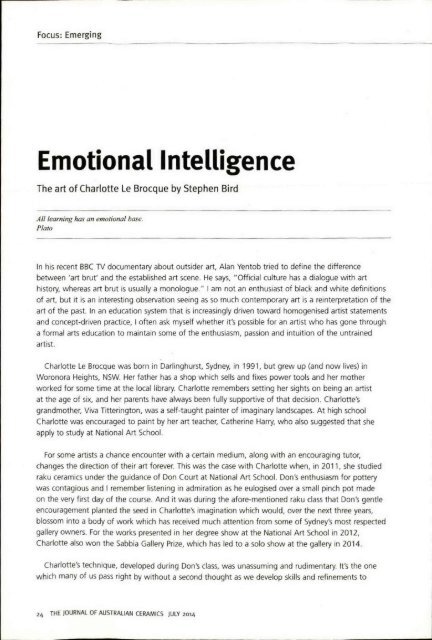The Journal of Australian Ceramics Vol 53 No 2 July 2014
Create successful ePaper yourself
Turn your PDF publications into a flip-book with our unique Google optimized e-Paper software.
Focus: Emerging<br />
Emotional Intelligence<br />
<strong>The</strong> art <strong>of</strong> Charlotte Le Brocque by Stephen Bird<br />
All learning has an emotional base.<br />
PlaID<br />
In his recent BBC TV documentary about outsider art, Alan Yentob tried to define the difference<br />
between 'art brut' and the established art scene. He says, "Official culture has a dialogue with art<br />
history, whereas art brut is usually a monologue." I am not an enthusiast <strong>of</strong> black and white definitions<br />
<strong>of</strong> art, but it is an interesting observation seeing as so much contemporary art is a reinterpretation <strong>of</strong> the<br />
art <strong>of</strong> the past. In an education system that is increasingly driven toward homogenised artist statements<br />
and concept-driven practice, I <strong>of</strong>ten ask myself whether it's possible for an artist who has gone through<br />
a formal arts education to maintain some <strong>of</strong> the enthusiasm, passion and intuition <strong>of</strong> the untrained<br />
artist.<br />
Charlotte Le Brocque was born in Darlinghurst, Sydney, in 1991, but grew up (and now lives) in<br />
Woronora Heights, NSW. Her father has a shop which sells and fixes power tools and her mother<br />
worked for some time at the local library. Charlotte remembers setting her sights on being an artist<br />
at the age <strong>of</strong> six, and her parents have always been fully supportive <strong>of</strong> that decision. Charlotte'S<br />
grandmother, Viva Titterington, was a self-taught painter <strong>of</strong> imaginary landscapes. At high school<br />
Charlotte was encouraged to paint by her art teacher, Catherine Harry, who also suggested that she<br />
apply to study at National Art School.<br />
For some artists a chance encounter with a certain medium, along with an encouraging tutor,<br />
changes the direction <strong>of</strong> their art forever. This was the case with Charlotte when, in 2011, she studied<br />
raku ceramics under the guidance <strong>of</strong> Don Court at National Art School. Don's enthusiasm for pottery<br />
was contagious and I remember listening in admiration as he eulogised over a small pinch pot made<br />
on the very first day <strong>of</strong> the course. And it was during the afore-mentioned raku class that Don's gentle<br />
encouragement planted the seed in Charlotte's imagination which WOUld, over the next three years,<br />
blossom into a body <strong>of</strong> work which has received much attention from some <strong>of</strong> Sydney's most respected<br />
gallery owners. For the works presented in her degree show at the National Art School in 2012,<br />
Charlotte also won the Sabbia Gallery Prize, which has led to a solo show at the gallery in <strong>2014</strong>.<br />
Charlotte's technique, developed during Don's class, was unassuming and rudimentary. It's the one<br />
which many <strong>of</strong> us pass right by without a second thought as we develop skillS and refinements to<br />
24 THE JOURNAL OF AUSTRALIAN CERAMICS JULY 20'4

















